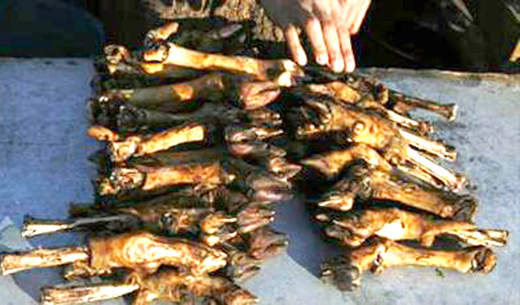There is Kashmiri brain behind Amritsar’s famous Bheja Fry. From importers of mutton worth around 700 crore a year, Kashmir feeds the growing appetite of Indian market for lamb brain, reports Junaid Rather
Kashmir is witnessing a brain drain of a different kind, not the intellectual one with people leaving for other countries to apply their minds, but it is a drain of protein source with lamb brains now being exported outside the state.
The second line genera of mutton dealers, who deal with the mutton sourced from a lambs head, are having a brisk business as orders for supply of ‘brains’ are now coming from north India with Amritsar becoming the hub of trade for these Kashmir imports.
“There is a tremendous demand in Amritsar and Jammu for these sheep products. The sheep brain is traded at Rupees 15 in Kashmir while it is sold for Rs 50 per piece in Amritsar,” said Khazir Mohammad Riggo, President Mutton Dealers Association Kashmir.
“There is always a fixed rate for those dealers who buy sheep heads from butcher and it does not fluctuate as is the case with the wholesome mutton segment,” Riggo said.
He said that there, they have an edge over stability in prices and the addition of the new market had added to their income.
Kashmir is one of the leading states in consuming mutton. The official statistics say that Jammu and Kashmir annually consumes a whooping 51,000 tones of mutton. Other sheep products are found in abundance in the valley, as well. The people associated with this trade claim that 60 percent of head meat is now being exported to Amritsar and Jammu.
The lamb brains are in great demand as in Amritsar and other parts of Punjab. Hotels and dhabas (roadside kiosks) in these places serve a special dish made from sheep brains called ‘bheja fry’.
To keep the stuff fresh, an exclusive transport service, mainly Tata Sumo’s, rush the stuff to Jammu where ice packing is carried in thermo cool cartons before dispatching them to Amritsar by train or bus.
However, the hub of this trade activity according to dealers has shifted to South Kashmir’s Anantnag district, which has an edge of better connectivity with a highway as well as train service.
All the lamb brains from other districts, mostly from Srinagar are received by dealers at Anantnag to be sent to Jammu and Amritsar.
Kashmir in recent years has picked tremendous changes in acceptance of foods. In past the head meat and hooves would have been a preference for a particular section of the society mainly of poor class as it was considered as a cheaper source of protein. But now its acceptance is notable. People from all classes enjoy it now.
The majority in the Valley believe that the change in food culture came after valley witnessed a boom in food joints. The people of Kashmir were introduced to the different varieties of different cultures. Most of the food joints are either run by non residents or have non-local cooks.
There however is a vibrant market available, for heads and hooves, in Kashmir as well with its demand also picking up as wholesome mutton has become too costly selling at Rs 350 per Kilogram.
Known locally as kalmaaz, head meat is also a savored delicacy in Kashmir as are sheep brains (kod) and hooves (paachi).
“On an average, head meat and hooves worth Rs 8 Lakh are sold in Kashmir on daily basis,” says Rigoo.
In Srinagar, there are 200 butchers who exclusively sell head meat and hooves. On the street of Sarai Bala, a roadside butcher Bashir Ahmad who is associated with this trade from last two decades says that there has been an enormous change in its consumption.
“Earlier there was a particular section of the society who would eat it. Now the scenario has changed and at times the demand is so high that customers pay us in advance for their orders,” he said.
Boneless head meat is sold at Rs 170 per KG while hooves are sold at Rs 85 per KG. The demand for hooves increases during the winters as it is thought to be beneficial for health in cold.
A local processing before cooking for sheep legs is all together different. Pair of legs is charred over fire (mostly on kerosene stove) until completely blackened. This process burns the fur and skins are scrapped off.
Bashir says that the business doesn’t remain confined to the dealers and butchers only but also provides employment to hundreds of women mostly destitute who find the job a means of earning their livelihood.
“We give these hooves to different families in old city who clean them so that are edible. We give them Rs 20 for cleaning a set of hooves of an animal,” said Bashir.
Adding that at times they are also being provide kerosene for the running the stoves. The increase in demand for head meat has also been due to roadside barbeque vendors, says another butcher Gulzar Ahmad.
“Every vendor buys the meat from a permanent butcher,” he says.
















